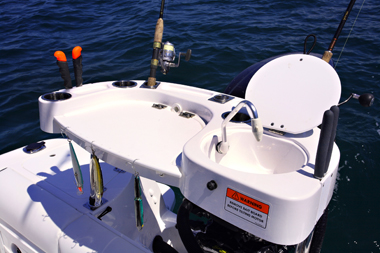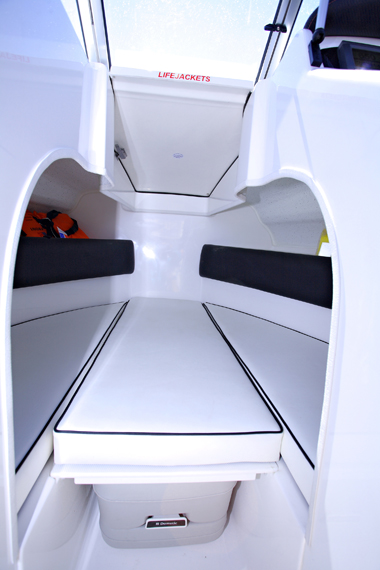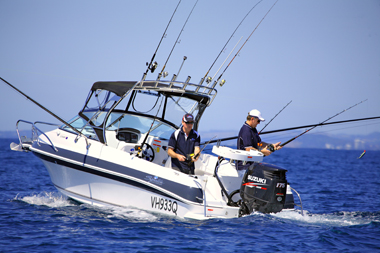Haines Signature 575RF
- NAFA
- Feb 1, 2013
- 4 min read
THE SPECIAL SIGNATURE BY WARREN STEPTOE
The all-new Signature 575RF is a hard-core fishing boat that also caters for family boating fun.
Signature’s ‘RF’ series has always been something special. The 600 RF is a Haines classic and goes way back to the very beginnings of Signature when John Haines senior (Hainesy to everyone who knew him) presented his version of a truly-excellent fishing boat. As newer version replaced new version, it only got better, picking up a bevy of awards along the way.
Then came the 542 RF, a little sister subsequently updated to the 543 RF, with all the same sentiments behind it and very much a smaller version of a brilliant fishing/family boat regardless of a name change that went almost unnoticed. So what’s in a name?
Plenty in this case; RF so I’m told stands for Runabout Fishing. It could easily be Fishing Runabout because, while all Haines family boats blend a degree of suitability for family boating into even its dedicated fishing models, its hard-core boats (of which the RF series is as hard as they get) clearly place fishing at the top or its priority list.
Which brings us to the first of a whole new generation of boats from Signature: the 575 RF. Hainesy is no longer with us unfortunately, but I can see a huge smile all over his face about this boat: the first all new model from Signature since his untimely passing.
Hainesy’s legacy is in good hands. With his sons John (widely known as John Junior for obvious reasons) and Greg at the helm, the Haines Group lacks nothing in small-boat-building expertise and the 575 RF demonstrates it in no uncertain terms. John and Greg were schooled in small boats literally from the cradle. If you like the way this particular 575RF is set up as much as I did, it may have something to do with it being John’s (Junior) own boat.
John’s Company Boat sports $22k odd worth of options and extras, some of which would make any keen fisho drool – like an integrated Garmin sounder/GPS and engine instrumentation package that’s to hope you win Gold Lotto for. No you don’t actually need to spend nearly $87k to have your 575 RF set up as a great fishing boat. Although we’d all like to!
So firstly the new hull: at 5.7m, a nominal 18 feet to old salts like me, the 575RF fits perfectly between its larger and smaller stablemates. In many ways, 18 old-fashioned feet is a perfect compromise for a fishing boat that’s big enough for serious offshore fishing while still small enough for estuary and bay fishing not to cramp its style.
When Hainesy introduced what’s now known as the Haines Group’s SVDH (Signature Variable Deadrise Hull) hull, it ranked amongst the most sophisticated small boat hulls in the world. And today’s version is still right up there. I heard Haines Group staffers referring to the 575 RF hull as Generation 7 and, while refinements are subtle, they’re nonetheless profound for it.
A notch in the forefoot is noticeable on walking past the boat on the trailer. Apparently this is there to avoid that annoying habit boats have of sneezing spray forward. In a word, the notch works!
Not so immediately noticeable is a subtle reshaping of the hull bottom aft between the chine and first strake. This then acts as a built-in trim tab, minimising any tendency for the hull to squat at the stern as it transitions from displacement speeds to planing.
Typically, Haines Group staffers running the 575RF for NAFA’s photo shoot had to set out a lure pattern to demonstrate how the new hull planes easily at under 6 knots. No, nothing ate the lures, but anyone who habitually high speed trolls lures will love fuel consumption around half a litre/km.
At speed offshore, the 575 RF was nothing short of a delight. The hull comprises two primary mouldings for outer hull and deck with the space between foam filled, and bonded with a proprietary process the Haines Group call Nexus into a singular unit with formidable structural integrity. The spin-off is that this has to be one of the quietest over-the-water small boats I’ve ever ridden in.
Inside the 575RF is a demonstration of just how good for fishing a runabout can be. Cockpit space has clearly been maximised while a walk-through screen and foredeck make what once was an awkward area of the runabout configuration a complete non-event. Bow access in this boat is as good as it gets. The foredeck has been kept deliberately low making the area each side of the walkthrough pure dry stowage space.
Out in the cockpit, essential leg support is maintained right around the periphery with a moulded non-slip deck surface underfoot, massive double side-pockets (one of which has a fish measure etched in) and built-in tackle stowage in each aft corner.
At the transom, there are a transom door portside with a live-bait tank to starboard. The workbench perched above the transom in our photo spread is an option few will do without. Fish can go safely away under the deck in a built-in (effectively insulated by the foam-filled hull) fish box.
The helm is designed for the boat to be driven in equal comfort whether standing or seated. Even with John Haines’ indulgence in electronics and instrumentation, there was room to spare in the dash area. The fact he’s a family man with small children is revealed by a neat fold-away aft lounge that emerges from the transom bulkhead; and a portable ‘loo hidden away beneath an upholstered centre infill beneath the foredeck. Getting kids or friends aboard from the water or a beach is facilitated by a telescopic ladder slotted unobtrusively into a small step outside the transom door.
So while this is a more hard-core fishing boat than family runabout, family boating is well catered for too.













